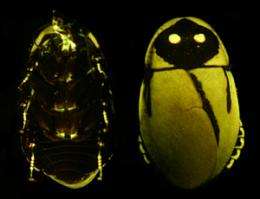August 23, 2012 report
Researchers seek to explain why there are so few land dwelling bioluminescent species

(Phys.org)—Visitors to the world's oceans are likely to find a wide variety of bioluminescent creatures, especially as they descend to depths where sunlight can't reach. The ability to glow has evolved in underwater organisms for a variety of reasons, from attracting prey to helping find a mate. On land however, things are very different. Other than 13 known species of insects, which of course include the firefly, very few other creatures have evolved the ability to glow and now, new research suggests that virtually all of them evolved much more recently than did marine dwellers. Peter Vršanský and colleagues from the Slovak Academy of Sciences have found after studying the collective history of all known bioluminescent species that land dwellers apparently evolved from a single source some sixty five million years ago, whereas their marine counterparts first came about closer to four hundred million years ago. Their paper describing their findings has been published in the journal Naturwissenschaften.
The work by Vršanský el al comes on the heels of news that a rare species of cockroach, Lucihormetica luckae, specimens of which were found on the slope of a volcano before its subsequent eruption, appear to glow to mimic the click beetle which lives in the same general area. Click beetles glow, researchers believe, to warn predators of its toxic nature, thus preserving itself. The cockroach that mimics it on the other hand is not toxic, but it's markings are so similar that it appears it evolved it's luminescent abilities for the express purpose of fooling predators into thinking it was a click beetle and thus toxic.
Vršanský and colleagues believe it's possible that land dwelling bioluminescent species came to exist only after nocturnal life on land diversified to the point where such an ability would be useful. They also theorize that it's possible that it took longer for bioluminescence to evolve in land creatures because of the toxic nature of the chemicals involved in growing glowing organs. Marine animals live in a colder and in some sense cleaner environment, it's easy to wash away residue. Land species on the other hand would have had to evolve a way dispose of the toxins in a way that didn't harm its carrier.
The team also notes that because land dwelling bioluminescent species are so rare, it's likely they might be at risk of disappearing altogether. L. luckae might be gone already, as no specimens have been found since the volcano on which it lived, erupted. And the most evident example of them all, the firefly has been found to be dwindling in numbers over the past decade as well.
More information: Light-mimicking cockroaches indicate Tertiary origin of recent terrestrial luminescence, Naturwissenschaften, DOI: 10.1007/s00114-012-0956-7
Abstract
Bioluminescence is a common feature of the communication and defence of marine organisms, but this phenomenon is highly restricted in the terrestrial biota. Here, we present a geographical distribution of only the third order of luminescent insects—luminescent cockroaches, with all 13 known and/or herein reported new living species (based on deposited specimens). We show that, for the first time, photo-characteristics of three examined species are nearly identical with those of toxic luminescent click beetles, which they mimic. These observations are the evidence for the mimicry by light—a new type of defensive, Batesian and interordinal mimicry. Our analysis surprisingly reveals an evolutionary novelty of all living luminescent insects, while in the sea (and possibly in the soil) luminescence is present also phylogenetically in very primitive organisms.
Journal information: Naturwissenschaften
© 2012 Phys.org


















